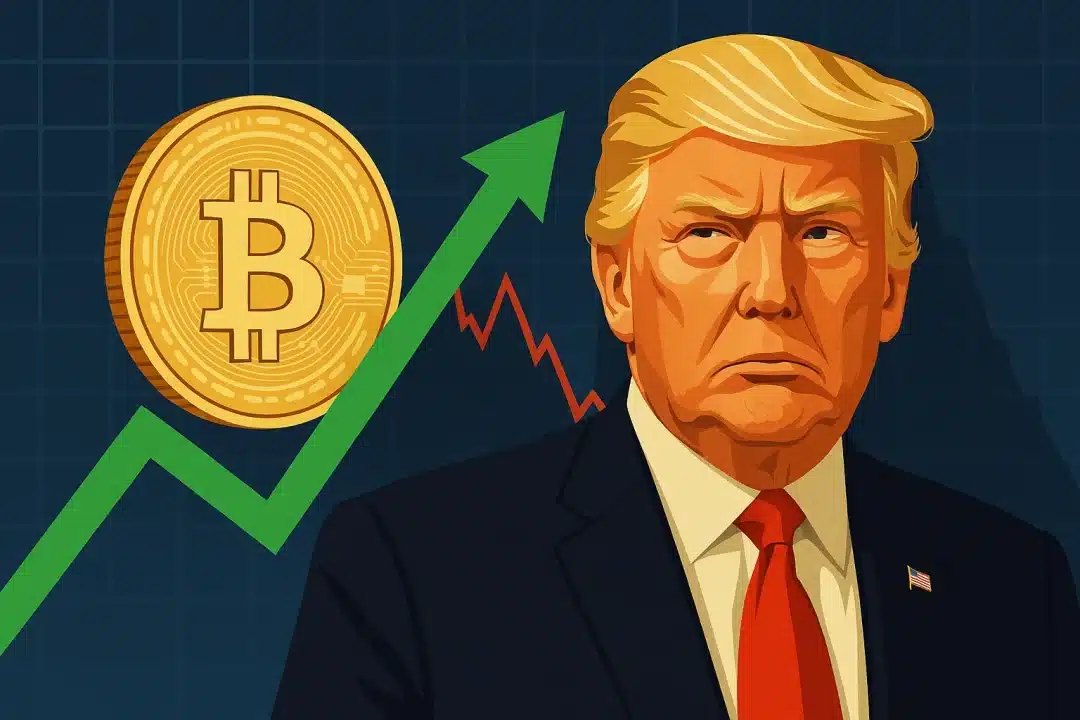

Bitcoin’s rally has hit a wall. After soaring to new heights earlier this year, Bitcoin has dropped below the $78,000 mark as investor sentiment was rattled by renewed economic uncertainty and geopolitical tensions.
The sharp pullback has reignited concerns about the sustainability of Bitcoin’s recent gains and whether another bull cycle may be losing steam—or merely pausing before the next leg up.
📉 What Caused the Bitcoin Sell-Off?
The immediate trigger for the decline appears to be growing anxiety over President Donald Trump’s latest threats of aggressive trade tariffs. As part of his 2024 campaign rhetoric and post-election influence, Trump has floated the idea of implementing broad tariffs on imports—raising alarms among global investors about inflation and reduced international trade.
“Risk assets across the board are feeling the pressure,” said Joel Kruger, a market strategist at LMAX Group. “Bitcoin, while often touted as a hedge, still trades like a high-beta tech stock when uncertainty spikes.”
Other contributing factors include:
- Profit-taking after Bitcoin briefly touched record highs above $80,000 in March.
- Regulatory scrutiny in both the U.S. and Europe, with the SEC intensifying its oversight of crypto exchanges and stablecoins.
- A strengthening U.S. dollar, which often signals reduced appetite for alternative assets.
Analysts Split on BTC’s Short-Term Outlook
The question now dominating crypto circles: Can Bitcoin bounce back in the weeks ahead—or is the correction just beginning?
Bullish Perspective: A Healthy Correction
Many long-term crypto bulls see the dip as a normal retracement in an ongoing macro bull trend. Historically, Bitcoin has faced multiple 20-30% corrections even during major uptrends.
“This isn’t the first time Bitcoin has tested investor conviction,” said Cathie Wood of ARK Invest. “The fundamentals remain strong—on-chain data shows accumulation, and institutional interest is far from fading.”
Other bullish indicators include:
- Rising Bitcoin dominance, suggesting capital isn’t exiting the crypto market entirely.
- Bitcoin ETF inflows remain positive despite the price pullback.
- Supply-side constraints post-2024 halving continue to support long-term scarcity narratives.
Bearish Perspective: Macro Conditions Could Worsen
However, some analysts are warning that the worst may not be over, especially if Trump’s economic policy shifts become more concrete.
“Markets don’t like surprises, and Trump’s tariff talk has the potential to introduce real economic friction,” said Noelle Acheson, former head of market insights at Genesis. “That could reduce risk appetite significantly—bad news for Bitcoin in the short term.”
Additionally:
- Liquidity is tightening globally, with central banks less inclined to cut rates quickly.
- Retail sentiment is cooling, as Google searches for “buy Bitcoin” have dropped sharply in the past week.
- Altcoin markets are bleeding, a possible sign that broader confidence in the space is weakening.
🪙 Bitcoin Dip a Buying Opportunity?
For retail investors, the recent downturn presents a classic dilemma: buy the dip or wait for further declines?
Veteran trader Peter Brandt advises caution. “Dips are great opportunities, but timing matters. We may still see BTC test support at $70K or lower.”
Recommended strategies from analysts include:
- Dollar-cost averaging (DCA) to smooth out volatility
- Rotating into stablecoins or Bitcoin ETFs for more predictable exposure
- Watching key support levels at $72K and $68K for potential bounce zones
🌐 Bitcoin’s Role in a Shifting Global Economy
Amid traditional market jitters and political unrest, Bitcoin’s value as a decentralized store of wealth may still resonate with global investors. However, its ability to act as a true safe haven is again being tested.
“Bitcoin is no longer in its experimental phase—it’s a trillion-dollar asset. That means macro forces, not memes, will drive its trajectory in 2025,” said economist Lyn Alden.
As the U.S. presidential race heats up, and with central banks walking a fine line between inflation and recession, Bitcoin’s volatility could remain elevated through the summer.
Bottom Line
The current Bitcoin sell-off reflects a complex mix of macroeconomic uncertainty, geopolitical risk, and market psychology. While some analysts believe the pullback is a buying opportunity within a broader bullish cycle, others warn that policy shifts and risk-off sentiment could deepen the decline.
One thing is clear: Bitcoin has once again reminded investors that high reward comes with high volatility. Whether BTC bounces back quickly—or continues to correct—will likely depend as much on global policy decisions as it does on crypto fundamentals.




